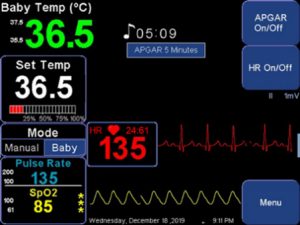![]()

Specialized neonatologists on the forefront of neonatal resuscitation continue to fine-tune practice algorithms to standardize resuscitation, education, and training practices around the world. Improvements in outcomes, largely attributed to these advancements, are nothing short of amazing with a 52% reduction in neonatal deaths since 1990 [1].
The European Resuscitation Council (ECR) recently released their 2021 Newborn resuscitation and transition support guidelines. [2] The guidelines provide detailed recommendations supported by clinical evidence. The guidelines, like the 2015 edition, outline the advantages of ECG to acquire a heart rate during resuscitation. ECG provides continuous monitoring for a “more dynamic indication of heart rate change”. Heart rate detection by ECG has been shown to be more accurate and faster than other methods, such as estimates based on the caregiver listening with a stethoscope or counting pulsations through the umbilical cord.

In line with these recommendations, GE Healthcare introduced the Panda Warmer ResusViewTM to the European market [3] after it received CE mark last year. Panda Warmer ResusView is an infant radiant warmer designed to provide critical stabilization and resuscitation tools in a single integrated platform. Built upon the previous design, it now has both integrated pulse oximetry and heart rate measurement via ECG technology, which are critical parameters that guide clinical actions during resuscitation. Integration of both parameters into the warmer provides a streamlined approach to assess newborns during the golden hour, with a single view of the newborn’s temperature, oxygen saturation, heart rate and the time without the need for additional equipment.
ResusView provides the measurement of heart rate via ECG technology, which distinguishes itself from traditional cardiorespiratory monitors. The feature calculates heart rate from the signals obtained via the ECG leads and has been specifically designed for newborn resuscitation immediately following birth. The feature detects sharper QRS with shorter durations, which adult algorithms may not typically be designed to detect. During a critical care workflow, like newborn resuscitation, artifacts (or false values) can cause inaccuracies in ECG QRS detection and consequently the heart rate value displayed. Artifacts can be caused by necessary resuscitation actions like stimulation, drying, and positioning of the newborn. The ResusView feature was designed to resist these common short-term motion artifacts. ResusView was made to recover quickly from severe artifact and filter-out these false values, which allows it to maintain a stable and continuous heart rate while maximizing the potential for a high degree of accuracy. Precise clinical actions should be supported by precise and accurate heart rate detection tailored to newborns following birth.
In addition, clinical decisions during resuscitation need to be made quickly. With this in mind, the ResusView feature was designed to detect and track the heart rate quickly without compromising accuracy. Do you know your time to first heart rate? With the ResusView feature on, after leads are placed on the newborn, and the waveform starts – it will display heart rate in less than or equal to 6 seconds when the heart rate is between 60-119 bpm. In comparison, in one study, the median time to acquire a signal from pulse ox was 32 seconds. [4]
During clinical evaluation of Panda Warmer ResusView, 82% of users said they felt they were able to acquire a heart rate value quicker and easier with ResusView during a resuscitation event than with a stand-alone physiological monitor. [5] As resuscitation science and guidelines continue to develop and change, tools provided to clinicians need to also develop and change. The fragile patients and the skilled clinicians who care for them – deserve the best.
- United Nations Inter-agency Group for Child Mortality Estimation (UN IGME), ‘Levels & Trends in Child Mortality: Report 2020, Estimates developed by the United Nations Inter-agency Group for Child Mortality Estimation’, United Nations Children’s Fund, New York, 2020.
- Madar, et al., European Resuscitation Council Guidelines 2021: Newborn resuscitation and support of transition of infants at birth, Resuscitation (2021), https://doi.org/10.1016/j.resuscitation.2021.02.
- Not available in all countries.
- Katheria A, Rich W, Finer N. Electrocardiogram provides a continuous heart rate faster than oximetry during neonatal resuscitation. Pediatrics. 2012;130:e1177–e1181. doi: 10.1542/ peds.2012-0784.
- GE external evaluation report; clinical evaluations conducted at 2 US medical centers Sept’19-Nov’19, user survey results N=20

